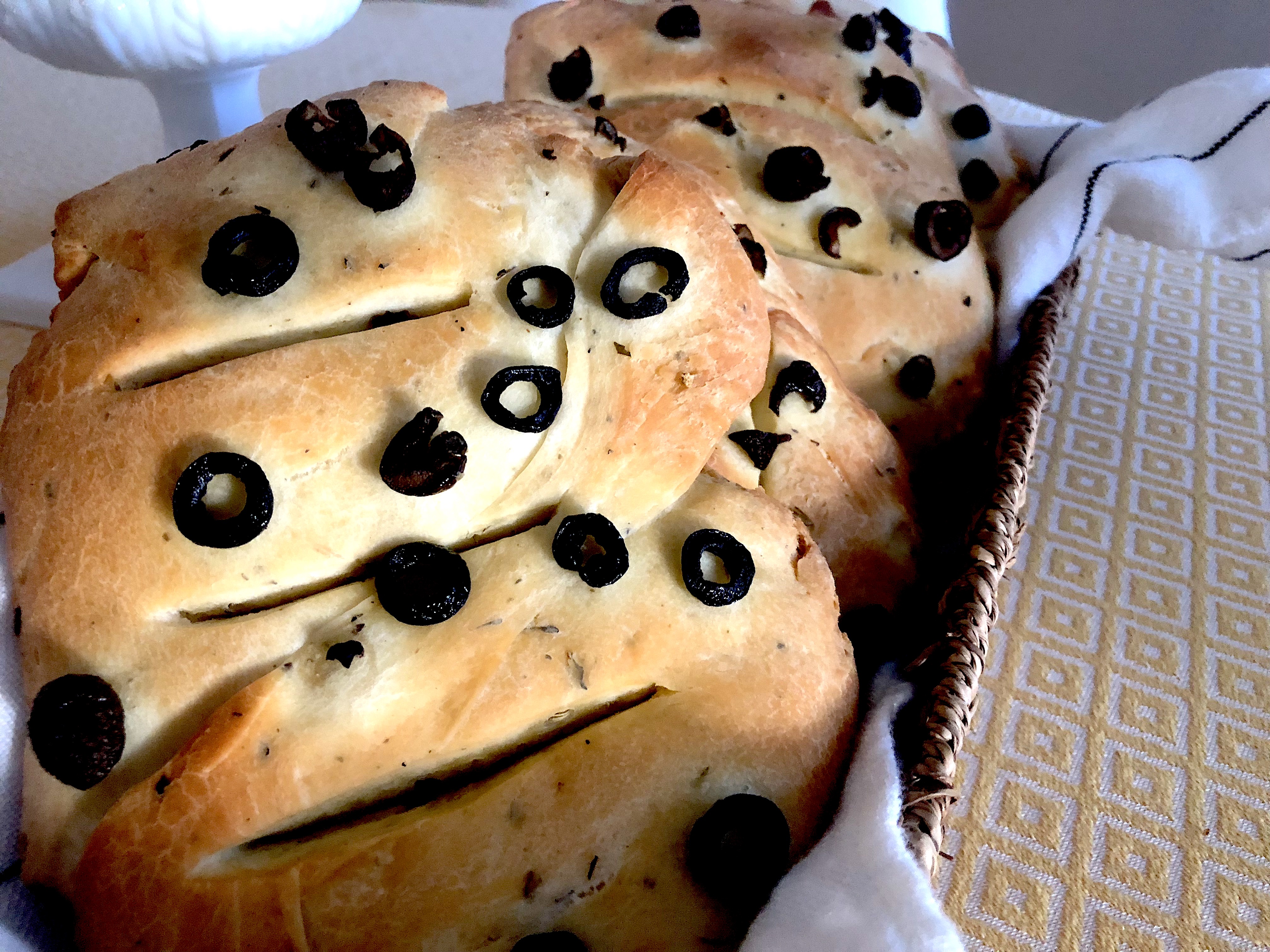Become a Member for as little as $4/mo and enjoy unlimited reading of TSLL blog.
The first time I tasted Provençal fougasse was just outside Gordes (sitting outside on this terrasse at my vacation rental in a lovely little quiet hamlet during apéro time (aka an aperitif) with a glass of rosé, pistachios and olives from Provence. In a word – perfect.
The bread’s density offers a simple abundance of classic Provençal flavors – olive, marjoram, rosemary, thyme, and oregano and flour (there are many wheat fields in this area). As well, the extra ingredients as filling – crackling and olives (each in a separate loaf) are a wonderful extra surprise inside the bread should you choose to infuse the bread with these additions.
Dating back to ancient Rome, Fougasse (pronounced foo-gaas – fun to say, right?), what eventually became Provençal flat bread, also led to Italy’s focaccia flat bread.
Fougasse is a bread that bakes rather quickly due to the slashes in the bread. This cutting design is intended to create the image of a wheat leaf or wheat sheath. As well, fougasse is a dense bread, so do not expect anything light and airy like a baguette. Enjoyed prior to a meal, often with a glass of wine and other simple nibbles as I described above, you can pick up a loaf in Provence or make one yourself wherever you call home.
Below is a recipe that was adapted from three different recipes – Patricia Wells‘, Rodolphe Landemaine (who Patricia Wells recommends) and this recipe. As you will see in my images, I added the olives afterward rolling out the bread after I initially added them to the dough too soon (pre-rising). If you want to add olives, I would recommend, as the third recipe does and adding them (or the crackling) after the bread has risen and before you roll it out.
Either way, the Herbes de Provence fills the kitchen with the scents of the south of France and the bread is a good, hearty bite of goodness. Enjoy!
~View more of TSLL Recipes here
French Week 2018 – Posts So Far . . .
Guests Who Stopped By for a Conversation:
- #221: Waking Up In Paris Author Sonia Choquette — A Conversation on Reinvention
- Aix-en-Provence & M.L. Longworth – Talking about the Paris of the South of France
- A Conversation with Sharon Santoni & A Very Special Giveaway
- #222: Oliver Gee of The Earful Tower Podcast
Traveling to France
- TSLL’s Tour of Les Jardins de Villandry (enjoy a 3 minute relaxing tour of the grounds)
- Claude Monet’s Giverny: My Time with the Famous Waterlilies and Those Copper Pots & Pans
- All You Need to Know About the Markets in Provence (and in France for that matter)
- A Country B & B in the City of Amboise: Le Manoir de la Maison Blanche
- Hôtel Particulier Montmartre – Quiet Luxury in Paris
- Where to Stay in Luxury in France, yet Simply So – TSLL Recommends
- How to Successfully Rent a Car (and Drive in Europe and Britain as a Tourist
Shopping French Products
- French Linens: The Fields, The History, and Why It is Truly Luxurious Fabric (and where to find a sheet set of your own)
- Find Your Perfect Provence (Simply French) Market Tote
Extra French Posts
- Cooking in Provence with Patricia Wells
- A Review of Tish Jett’s New Book: Living Forever Chic
- Lunch with Julia Child at La Couronne in Rouen, France
Giveaways (enter by August 18)
- Giveaway – French Wall Decor Prints from Modvin
- A Linen Giveaway from Soak & Sleep
- A Conversation with Sharon Santoni & A Very Special Giveaway
TSLL’s 3rd Annual French Week continues through August 19th with at least two posts per day. À bientôt!
~Catch up on all of TSLL’s French-Inspired posts here and French-inspired podcast episodes here.

Herbes de Provence Fougasse with Crackling or Olives
Ingredients
Yeast Mixture
- 2 teaspoons dry, active yeast
- 1 tablespoon sugar
- 1 cup warm water
Dough
- 1 pound white bread flour
- 2 Tablespoons extra-wiring olive oil
- 1 teaspoon fine sea salt
- 1 tablespoon Herbes de Provence
- 1/2 cup sliced olives or crackling (cubed pig's fat) optional - the olives can be added to the top, but they don't' provide the full desired flavor this way.
Instructions
Making the Dough
- Mix the dry yeast, warm water and sugar together in a small bowl until incorporated and then let set for 5 minutes. You are feeding the yeast essentially with the sugar, so you will begin to see small bubbles occur in the mixture. This is a good thing.
- In the bowl with the yeast add a handful of flour and mix in with the wet yeast mixture until a wet dough is formed. Let sit for one hour on at room temperature.
- At a slow speed/pace, add the salt, Herbes de Provence and the remaining flour to the wet dough. Once all the flour is added creating a slightly wet dough (you may not need all the flour or you may need a little more. Knead the dough for 10-12 minutes. When complete, the dough should be soft and smooth.

- Place the dough (a ball shape) into a bowl, cover well with plastic wrap and place into the refrigerator for at least 8 hours, and up to a couple of days. Allow the dough time to rise to twice its original size (this will be done in eight hours and it will hold unless you touch it).
Making the bread
- Heat the oven to 500 degrees Fahrenheit. Place a large baking sheet in the oven to warm.
- Remove the dough from the refrigerator, punch it down and separate into four separate pieces.
- If you are adding crackling: Cube in small squares the crackling (pig or duck's fat). In a skillet, cook as you would bacon - rendering the fat and cooking it until crisp. Drain the fat and keep the cooked crackling.
- Add the olives or crackling, if you are using these ingredients, to the dough now before you roll it out.
- Roll each ball into a rectangle of about 8 x 5 inches (approximate). Cut three slashes in each bread dough and gently open up the slashes, enlarging the slashed areas. Brush with each bread dough with olive oil

- Reduce the heat of the oven to 450 degrees and place the bread (which should be put on parchment paper on a baking sheet) onto the hot pan in the oven. Bake for 25-30 minutes until golden brown.




Looks scrumptious
Shannon. Lovely for sharing with apero. Did you know It’s also an.old fashioned type of landmine!!! In the Loire they have a flatbread called “fouace”. Without olives or herbes but very delicious?
Looks tasty and doable, ha! Thanks for sharing another French moment.
Pat
What a lovely way to be introduced to fougasse..or anything:) !
I am so looking forward to your Kitchen series.
XOXO
I have been looking for a good recipe for Olive Fougasse! Our Bakery Nouveau in West Seattle makes an addicting version. The addition of Herbes de Provence will only make it better! Thank you.
Absolutely! Thank you for sharing the bakery’s name in Seattle. Fougasse is delicious!
I make Fougasse and serve it during during apero at dinner parties. It is a hit and so easy to make.!
It is a perfect part of apéro time. 🙂